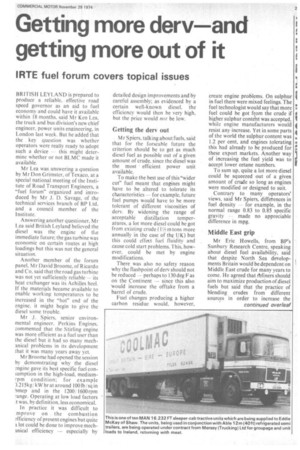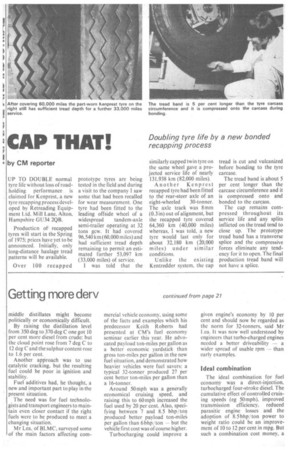Getting more dery and getting more out of it
Page 23

Page 24

Page 25

If you've noticed an error in this article please click here to report it so we can fix it.
IRTE fuel forum covers topical issues
BRITISH LEYLAND is prepared to produce a reliable, effective road speed governor as an aid to fuel economy and could have it available within 18 months, said Mr Ken Lea. the truck and bus division's new chief engineer, power units engineering, in London last week. But he added that the key question was whether operators were really ready to adopt such a device this might determine whether or not BLMC made it available.
Mr Lea was answering a question by Mr Don Grimster, of Texaco, at a special national meeting of the Institute of Road Transport Engineers, a "fuel forum" organized and introduced by Mr .1. D. Savage, of the technical services branch of BP Ltd, and a couneil member of the Institute.
Answering another questioner, Mr Lea said British Leyland believed the diesel was the engine of the immediate future; the gas turbine was economic on certain routes at high loadings but this was not the general situation.
Another member of the forum panel. Mr David Broome, of Ricardo and Co, said that the road gas turbine was not yet sufficiently reliable -its heat exchanger was its Achilles heel. If the materials became available to enable working temperatures to be increased in the "hot" end of the engine, it might begin to give the diesel some trouble.
Mr J. Spiers, senior environmental engineer. Perkins Engines, commented that the Stirling engine was more efficient as a fuel user than the diesel but it had so many mechanical problems in its development that it was many years away yet.
M r Broome had opened the session by demonstrating why the diesel engine gave its hest specific fuel conaumption in the high-load, mediumrpm condition: for example 215kg! kW hr at around 100 lb/ sq in lnnep and in the 12007 160Orpm range. Operating at low load factors it was, by definition, less economical.
In practice it was difficult to mprove on the combustion efficiency of present engines but quite a lot could be done to improve mechanical efficiency — especially by detailed design improvements and by careful assembly; as evidenced by a certain well-known diesel, the efficiency would then be very high, hut the price would not be low.
Getting the dery out
Mr S piers, talking about fuels, said that for the forseable future the criterion should be to get as much diesel fuel as possible out of a given amount of crude, since the diesel was the most efficient power unit available.
To make the best use of this"wider cut" fuel meant that engines might have to be altered to tolerate its characteristics — for example, future fuel pumps would have to be more tolerant of different viscosities of derv. By widening the range of acceptable distillation temperatures, a lot more diesel could be got from existing crude ( m tons more annually in the case of the UK) but this could effect fuel fluidity and cause cold start problems. This, however, could be met by engine modifications.
There was also no safety reason why the flashpoint of dery should not be reduced — perhaps to 130 deg F as on the Continent — since this also 'would increase the offtake from a barrel of crude.
Fuel changes producing a higher carbon residue would, however, create engine problems. On sulphur in fuel there were mixed feelings. The fuel technologist would say that more fuel could be got fkom the crude if higher sulphur content was accepted, while engine manufacturers would resist any increase. Yet in some parts of the world the sulphur content was 1.2 per cent, and engines tolerating this had already to be produced for these export markets. Another way of increasing the fuel yield was to accept lower cetane numbers.
To sum up, quite a lot more diesel could be squeezed out of a given amount of crude so long as engines were modified or designed to suit.
Contrary to many operators' views, said Mr Spiers, differences in fuel density — for example, in the normal range 0.83 to 0.85 specific gravity made no appreciable difference in mpg.
Middle East grip
Mr Eric Howells, from BP's Sunbury Research Centre, speaking about diesel fuel availability, said that despite North Sea developments Britain would be dependent on Middle East crude for many years to come. He agreed that Miners should aim to maximize production of diesel fuels but said that the practice of blending crudes from different sources in order to increase the middle distillates might become politically or economically difficult.
By raising the distillation level from 350 deg to 370 deg C one got 10 per cent more diesel from crude; but the cloud point rose from 7 deg C to 12 deg C and the sulphur content rose to 1.6 per cent..
Another approach was to use catalytic cracking, but the resulting fuel could be poor in ignition and stability.
Fuel additives had, he thought, a new and important part to play in the present situation.
The need was for fuel technologists and transport engineers to main tain even closer contact if the right fuels were to be produced to meet a changing situation.
Mr Lea, of BLMC, surveyed some of the main factors affecting corn mercial vehicle economy, using some of the facts and examples which his predecessor Keith Roberts had presented at CM's fuel economy seminar earlier this year. He advocated payload ton-miles per gallon as a better economic yardstick than gross ton-miles per gallon in the new fuel situation, and demonstrated how heavier vehicles were fuel savers: a typical 32-tonner produced 27 per cent better ton-miles per gallon than a 16-tonner.
Around 50mph was a generally economical cruising speed, and raising this to 60 mph increased the fuel used by 20 per cent. Also, specifying between 7 and 8.5 bhp /tOn produced better payload ton-miles per gallon than 6 bhp/ ton — but the vehiCle first cost was of course higher.
Turbocharging could improve a given engine's economy by 10 per cent and should now be regarded as the norm for 32-tonners, said Mr Lea. It was now well understood by engineers that turbo-charged engines needed a better thiveability — a wider spread of usable rpm — than early examples.
ideal combination The ideal combination for fuel economy was a direct-injection, turbocharged four-stroke diesel. The cumulative effect of controlled cruising speeds (eg 50mph), improved transmission efficiency, reduced parasitic engine losses and the adoption of 8.5 bhp/ ton power to weight ratio could be an improvement of 10 to 12 per cent in mpg. But such a combination cost money, a factor to be balanced against savings.
Asked whether thermostatic fans were worthwhile, and whether overcooling was a problem, Mr Lea said controlled fans were part of the future "economy package" but they would have to be made very reliable. And overcooling — especially of pistons — was not only uneconomic but was a potential smoke producer.
Mr Broome said that overcooling of the cylinder walls increased the viscosity of the lubricant so that piston friction losses rose sharply.
A questioner asked about mpg improvements through better aerodynamics, and Mr Lea said BLMC was looking at this, including the effect of changing coach shapes. Meanwhile, coach operators would save fuel if they accepted turbocharged engines more readily.
Mr Bradbury, the chairman, asked whether LPG as a partial fuel for diesels was promising. Mr Lea replied that the control system had to be rather complex and there were potentially reliability problems. Mr Broome added that the "gas off" control for low-load running was essential if unburnt gas was not to Prove wasteful and smelly.
Mr Howells said LPG was not all that freely available and the oil companies would be in real trouble if there were a big swing to LPG; the taxman might also become more interested.
Asked about the wider use of diesels at the lower powers, Mr Lea said British Leyland believed the diesel would be adopted by a large section of the present petrol market, particularly on light commercials, but BLMC had been inhibited by information that dery availability would he strictly limited. Now it appeared that this was not so, and work was going ahead fast on lowpower diesels.
Mr Spiers commented that the small diesel gave its best economy on part-load urban work, an advantage it largely lost on high-speed work.
Good economy could be achieved with the small diesel on high-speed running, said Mr Broome; if the bhp/ ton figure was right; recent work at Ricardo was showing encouraging figures.
When a questioner asked whether the transient stage as a turbocharger cut in caused emission problems. Mr Broome and Mr Lea said it did, and this aspect would be highlighted by the EEC free-acceleration smoke test regulations. There were ways of overcoming this, however, and trucks would move towards the type of turbo--charger response-delaying control used in rail traction, where the control came from an induction manifold pressure sensor.




























































































